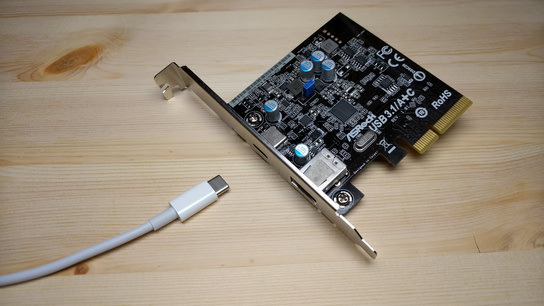My computer’s mainboard, an ASRock H270M Pro4, has a USB 3.1 Type-C connector port. However, it’s power delivery capabilities were quite underwhelming. I thought I’d look into the issue with a USB multimeter to investigate why my devices weren’t quick-charging. My investigation lead me to add-on a new USB 3.1 controller that was capable of delivering the promised power output of a Type-C connector.
Although the H270M mainboard’s USB-C port supports the full USB 3.1 Gen 1 specification when it comes to data speeds (5 GBps), it’s power delivery capabilities were capped at that of USB 2.0. That is to say, 0.45 ampere (A) at 4.45 volt (V), or just shy of 2 watt (W.) That is just ⅙ the power of my Nexus 5X’s original USB Type-C charger. No wonder my phone didn’t charge quickly from the USB-C port on my computer! For reference, the best performing USB 3.1 Type-A port on the same mainboard yields up to 0.65 A and 4.6 V, or 2.95 W.
So, my mainboard’s USB-C port was no good for charging anything. After reading up on the subject, I decided to upgrade my PC with another Type-C port which promised higher power delivery rates. The ASRock USB 3.1 (type A+C) PCI Express card was a natural choice, as it was the only card with documented support for Linux as well as Windows — and surprisingly even MacOS as well.
This PCIe card is a bit on the pricey side, but any card featuring the ASMedia ASM1142 chipset should have the same overall performance and power characteristics as the ASRock model I chose. The ASRock USB 3.1 (type A+C) features one USB 3.1 Type-A and one Type-C connector port. You can find other models from other manufacturers with the same chipset featuring two of the same port, if that’s more to your liking.
I’m happy to report that the ASM1142 works flawlessly without the need to install any additional drivers in Linux kernel 4.12 and in Windows 10 Creators Update. My computer did freak out and rebooted from Windows 10 without a bluescreen the first time I plugged in a USB Type-A cable in the card. However, I haven’t had any trouble with it in either Linux nor Windows other than that one-time incidence.
Using my USB-C multimeter, I was able to verify that my Nexus 5 X and a Samsung Galaxy S8 control device charges at full speed at 2.45 A at 5 V (12 W) off the Type-C port on the ASRock USB 3.1 (type A+C.) The ASRock card is advertised as supporting up to 3 A at 5 V (15 W.) This is six times the charging speed I got from my computer’s built-in USB-C port, and identical to the power delivered by the chargers that originally came with each phone.
The Type-A port on the ASRock USB 3.1 (type A+C) is also better than the best performing Type-A port on my mainboard. The ASMedia card delivered 0.7 A at 4.85 V (3.4 W), compared to 0.65 A and 4.6 V (2.95 W) from the mainboard. The ASRock card is advertised as supporting up to 1.5 A at 5 V (7.5 W.)
The product documentation on the ASRock USB 3.1 (type A+C) card says:
For charging Type-A USB devices, we suggest using the Type-A connectors on your motherboard.
I’m not clear what this warning is meant to suggest. There’s more than enough power through the PCIe 2.0 x4 connector to charge an USB-A and C device at the same time while delivering the maximum supported power on both ports. as mentioned already, my computer did a unexpected reboot the first time I used the Type-A port in Windows 10, but that only happen once! I’ve contacted ASRock about this and will update the review when I get a reply.
During my testing, I got very consistent power reading at each port. However, I also noted that the different USB 3.1 Type A ports on my mainboard gave off ampere from 0.45 to 0.65 and voltage from 4.3 to 4.65. This may be an indication that the power management on my ASRock H270M Pro4 mainboard may not be the best.
Unfortunately, I don’t have any device or test equipment available that will let me test the full data transfer speeds of the ASM1142.
All tests with USB-C–C cables where performed using two different Apple USB-C Charge Cables, as well as the original cables that came with the Nexus 5X and Samsung Galaxy S8. I’m happy to report that my test USB Type-C volt-/ammeter didn’t detect any notable difference in the cables whatsoever. Notably my multimeter isn’t all that accurate – and I don’t have the proper testing equipment to fully test the max load or USB Power Delivery handling.
